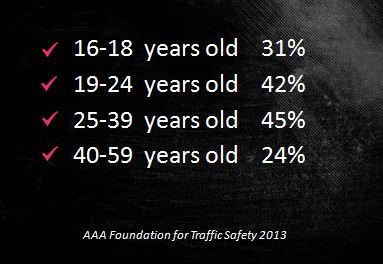
Teens are the most inexperienced of drivers and the fatal crash rates for teens is nearly three times that for any other age group. And distraction is thought to be responsible for more than 50% of teen crashes. Given that they are their tech savvy, that texting is their preferred form of communication and, as some would call it, their “addiction” to smartphones, a common perception is that most teen drivers text while driving. In my presentations with thousands of teens and adults, I always use the above slide.
Teens and adults invariably believe the answer is “True.”
But the correct answer is “False.” So adults and even teens, wrongly believe that the majority of 16-18 year olds text while driving. Here are the facts.
 Surprisingly, “only” 31% of teens text while driving according to the AAA Foundation for Traffic Safety study, and they are not the worst offenders. That distinction goes to the 19-24 and 25-39 year olds. The fact that about 1/3 of 16-18 year olds text while driving is scary, but that means that about 2/3 of 16-18 year olds do not. That is good news. But what effect does the misperception about the frequency of texting while driving for 16-18 year olds have? For those 16-18 year olds who don’t text and drive, they believe they are in the minority, and for those who do text and drive they wrongly believe they are just doing what everyone else is doing. According to social norms theory people incorrectly perceive the attitudes and behaviors of those in their community to be different than their own. With respect to risky behaviors the frequency with which these behaviors occur are overestimated and conversely, the frequency with which people engage in healthy behaviors is underestimated. Proponents of social norms theory believe that correction of these misperceptions can reduce the frequency of risky behaviors. See Berkowitz, A.D.( 2005). An Overview of the Social Norms Approach.
Surprisingly, “only” 31% of teens text while driving according to the AAA Foundation for Traffic Safety study, and they are not the worst offenders. That distinction goes to the 19-24 and 25-39 year olds. The fact that about 1/3 of 16-18 year olds text while driving is scary, but that means that about 2/3 of 16-18 year olds do not. That is good news. But what effect does the misperception about the frequency of texting while driving for 16-18 year olds have? For those 16-18 year olds who don’t text and drive, they believe they are in the minority, and for those who do text and drive they wrongly believe they are just doing what everyone else is doing. According to social norms theory people incorrectly perceive the attitudes and behaviors of those in their community to be different than their own. With respect to risky behaviors the frequency with which these behaviors occur are overestimated and conversely, the frequency with which people engage in healthy behaviors is underestimated. Proponents of social norms theory believe that correction of these misperceptions can reduce the frequency of risky behaviors. See Berkowitz, A.D.( 2005). An Overview of the Social Norms Approach.
Social norms theory proposes that focusing on the healthy practices of a community, as opposed to fear-based interventions, can result in less risky behaviors and an environment in which peers are more likely to speak up when seeing friends engage in risky behaviors. It does not appear that social norms theory has been utilized or evaluated with respect to distracted driving interventions. Applying these concepts to texting and driving , a non-texting 16-18 year old driver would be less likely to say something to friends who were texting while driving believing she was in the minority. And for those who do text and drive, the misperception that they are in the majority, that most 16-18 year olds do text and drive, supports and reinforces their risky behavior. Once having learned that they are actually in the minority, the theory proposes they would be more likely to reevaluate their behavior. Reported successes for social norms proponents have been in the areas of college drinking and tobacco use. See Berkowitz, supra.
As part of our EndDD.org presentations we share the facts concerning actual teen texting and driving, correct the misperceptions and also share facts suggesting that most teen drivers would stop texting, or driving distracted, if a friend asked them to stop. Preliminary results are promising. We also demonstrate, through role play, a non-confrontational intervention for passengers to use when their driver attempts to drive distracted which was adapted from a Colorado DOT and Bacchus Network project. It is hoped that these approaches will reduce distracted driving among teens. We will be surveying attendees, pre and post presentation, to evaluate the effectiveness of this approach for educational campaigns to keep teens safe.




